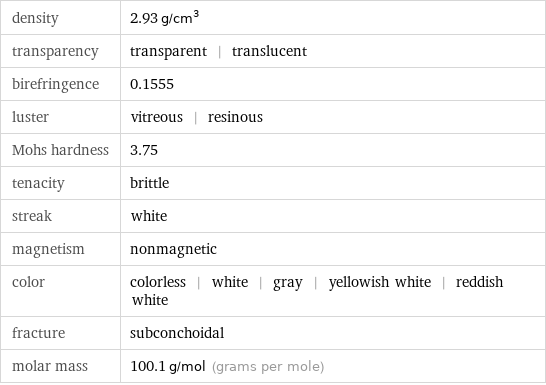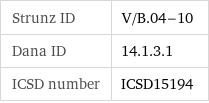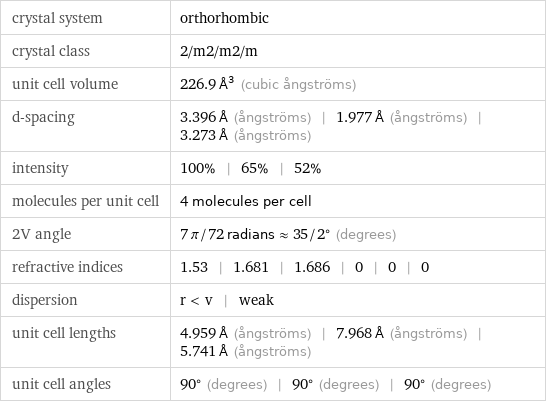Input interpretation

aragonite (mineral)
Image

Image
General properties

alternate names | arragonite | arragon spar | chimborazite | conchite | ctypeite | flos-ferri | iglite | igloite | ktypéite | oserskite | winnieite formula | CaCO_3 discovery year | 1797
Basic properties

density | 2.93 g/cm^3 transparency | transparent | translucent birefringence | 0.1555 luster | vitreous | resinous Mohs hardness | 3.75 tenacity | brittle streak | white magnetism | nonmagnetic color | colorless | white | gray | yellowish white | reddish white fracture | subconchoidal molar mass | 100.1 g/mol (grams per mole)
Units

Mineral identifiers

Strunz ID | V/B.04-10 Dana ID | 14.1.3.1 ICSD number | ICSD15194
Crystallographic properties

crystal system | orthorhombic crystal class | 2/m2/m2/m unit cell volume | 226.9 Å^3 (cubic ångströms) d-spacing | 3.396 Å (ångströms) | 1.977 Å (ångströms) | 3.273 Å (ångströms) intensity | 100% | 65% | 52% molecules per unit cell | 4 molecules per cell 2V angle | 7 π/72 radians≈35/2° (degrees) refractive indices | 1.53 | 1.681 | 1.686 | 0 | 0 | 0 dispersion | r < v | weak unit cell lengths | 4.959 Å (ångströms) | 7.968 Å (ångströms) | 5.741 Å (ångströms) unit cell angles | 90° (degrees) | 90° (degrees) | 90° (degrees)
Wikipedia summary

Aragonite is a carbonate mineral, one of the three most common naturally occurring crystal forms of calcium carbonate, Ca_C_O_3_________________ (the other forms being the minerals calcite and vaterite). It is formed by biological and physical processes, including precipitation from marine and freshwater environments.